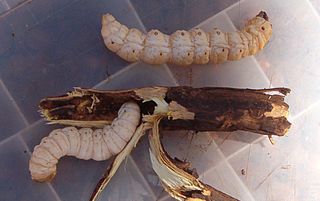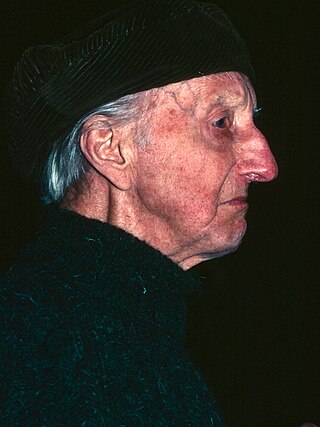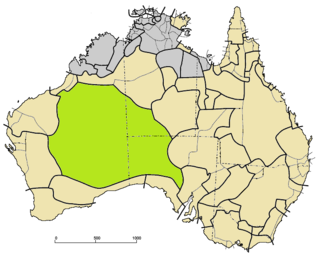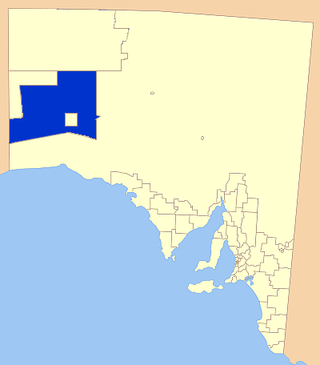
The Dreaming, also referred to as Dreamtime, is a term devised by early anthropologists to refer to a religio-cultural worldview attributed to Australian Aboriginal beliefs. It was originally used by Francis Gillen, quickly adopted by his colleague Baldwin Spencer and thereafter popularised by A. P. Elkin, who, however, later revised his views.

Uluru, also known as Ayers Rock and officially gazetted as Uluru / Ayers Rock, is a large sandstone formation in the centre of Australia. It is in the southern part of the Northern Territory, 335 km (208 mi) south-west of Alice Springs.

The witchetty grub is a term used in Australia for the large, white, wood-eating larvae of several moths. In particular, it applies to the larvae of the cossid moth Endoxyla leucomochla, which feeds on the roots of the witchetty bush that is widespread throughout the Northern Territory and also typically found in parts of Western Australia and South Australia, although it is also found elsewhere throughout Australia.

Maralinga, in the remote western areas of South Australia, was the site, measuring about 3,300 square kilometres (1,300 sq mi) in area, of British nuclear tests in the mid-1950s.

The Pitjantjatjara are an Aboriginal people of the Central Australian desert near Uluru. They are closely related to the Yankunytjatjara and Ngaanyatjarra and their languages are, to a large extent, mutually intelligible.

Aṉangu is the name used by members of several Aboriginal Australian groups, roughly approximate to the Western Desert cultural bloc, to describe themselves. The term, which embraces several distinct "tribes" or peoples, in particular the Ngaanyatjarra, Pitjantjatjara and Yankunytjatjara groups, is pronounced with the stress on the first syllable:.

William Ricketts (1898–1993) was an Australian potter and sculptor of the arts and crafts movement.

The Western Desert language, or Wati, is a dialect cluster of Australian Aboriginal languages in the Pama–Nyungan family.

The Maralinga Tjarutja, or Maralinga Tjarutja Council, is the corporation representing the traditional Anangu owners of the remote western areas of South Australia known as the Maralinga Tjarutja lands. The council was established by the Maralinga Tjarutja Land Rights Act 1984. The area is one of the four regions of South Australia classified as an Aboriginal Council (AC) and not incorporated within a local government area.

Pitjantjatjara is a dialect of the Western Desert language traditionally spoken by the Pitjantjatjara people of Central Australia. It is mutually intelligible with other varieties of the Western Desert language, and is particularly closely related to the Yankunytjatjara dialect. The names for the two groups are based on their respective words for 'come/go.'

A humpy, also known as a gunyah, wurley, wurly or wurlie, is a small, temporary shelter, traditionally used by Australian Aboriginal people. These impermanent dwellings, made of branches and bark, are sometimes called a lean-to, since they often rely on a standing tree for support.

Aṉangu Pitjantjatjara Yankunytjatjara, also known as APY, APY Lands or the Lands, is a large, sparsely-populated local government area (LGA) for Aboriginal people, located in the remote north west of South Australia. Some of the Aṉangu (people) of the Western Desert cultural bloc, in particular Pitjantjatjara, Yankunytjatjara and Ngaanyatjarra peoples, inhabit the Lands.
Charles Duguid was a Scottish-born medical practitioner, social reformer, Presbyterian lay leader and Aboriginal rights campaigner who lived in Adelaide, South Australia for most of his adult life, and recorded his experience working among the Aboriginal Australians in a number of books. He founded the Ernabella mission station in the far north of South Australia. The Pitjantjatjara people gave him the honorific Tjilpi, meaning "respected old man". He and his wife Phyllis Duguid, also an Aboriginal rights campaigner as well as women's rights activist, led much of the work on improving the lives of Aboriginal people in South Australia in the mid-twentieth century.
Pukatja is an Aboriginal community in the Anangu Pitjantjatjara Yankunytjatjara Lands in South Australia, comprising one of the six main communities on "The Lands".
Indulkana is an Aboriginal community in the Anangu Pitjantjatjara Yankunytjatjara Lands in South Australia, comprising one of the six main communities on "The Lands". At the 2016 Australian census, Indulkana had a population of 256.

The Anangu Pitjantjatjara Yankunytjatjara Land Rights Act 1981 grants certain land and other rights to the Anangu Pitjantjatjara Yankunytjatjara in South Australia. It began its life as the Pitjantjatjara Land Rights Act and commenced operation on 2 October 1981. Its long name title is "An Act to provide for the vesting of title to certain lands in the people known as Anangu Pitjantjatjara Yankunytjatjara; and for other purposes". The Act has since had several amendments, the latest in 2017.
The Aboriginal South Australians are the Indigenous people who lived in South Australia prior to the British colonisation of South Australia, and their descendants and their ancestors. There are difficulties in identifying the names, territorial boundaries, and language groups of the Aboriginal peoples of South Australia, including poor record-keeping and deliberate obfuscation, so only a rough approximation can be given here.
The Wenamba are an Aboriginal Australian people of the central eastern edge of Western Australia in the Goldfields Region.
The Matuntara are an Indigenous Australian people of the Northern Territory.
Phyllis Evelyn Duguid, née Lade, was an Australian teacher and Aboriginal rights and women's activist, who was highly regarded for her long-term commitment to those she saw as members of an underclass in society. She was married to, and often worked alongside, Charles Duguid, medical practitioner and Aboriginal rights campaigner, the couple leading much of the work on improving the lives of Aboriginal people in South Australia in the mid-twentieth century. She founded the League for the Protection and Advancement of Aboriginal and Half-Caste Women, which later became the Aborigines' Advancement League of South Australia (AALSA).













